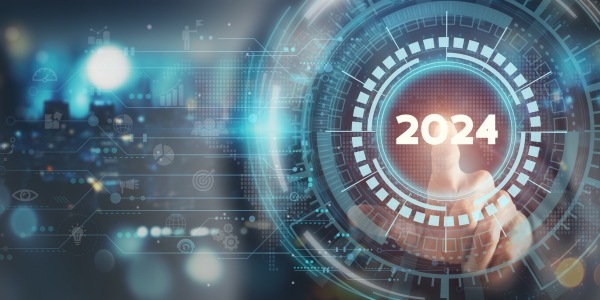Cybersecurity Threats to Gain Speed in 2024
As we pin our hopes and dreams on the new year, cybercriminals are already in motion to thwart any sense of security we might have gained in the digital world within the past year. What should you be concerned about?
A quick search for cybersecurity threat predictions for 2024 will bring up multiple articles listing anywhere from five to 20+ imminent issues. We’re sharing some of the top predictions and trends that cybersecurity experts agree on across the board.
7 of the Top Cybersecurity Threat Predictions:
- Rise in attacks powered by artificial intelligence (AI). These types of attacks are gaining momentum in corporations worldwide. One example we shared in a recent blog is how generative AI programs like ChatGPT are helping hackers write in perfect English and even mimic the style of trusted companies and individuals. Expect cybercriminals to make attacks more sophisticated and adaptive by leveraging AI and ML (machine learning) to automate and enhance their capabilities.
- Increase in ransomware attacks. According to Forbes, in 2024, cybercriminals are expected to target critical infrastructure and municipal services, too.
- IoT vulnerabilities. As the Internet of Things landscape expands, new vulnerabilities will arise, making it critical to prioritize security features, updates, and authentication mechanisms.
- Additional supply chain attacks. Threat actors will continue to focus on compromising software and hardware providers to infiltrate downstream targets.
- Biometric authentication challenges. As these security measures – such as fingerprint and facial recognition – become more widespread, so will the attempts to bypass or compromise these systems.
- International conflict. For example, Ukraine’s most extensive wireless network operator said attackers knocked its service offline on Dec. 12, disrupting critical infrastructure. As international conflicts drag on, according to a recent report, experts see a greater need to protect infrastructure against APTs (advanced persistent threats) and nation-state groups even when the network is thousands of miles away from the battlefield.
- Quantum computing threats. Quantum computers could break existing encryption algorithms with their massive computational power, necessitating the development of new encryption and security measures.
5 of the Top Trends for Mitigating Cybersecurity Threats:
- AI as a cybersecurity tool. With rapid advancements in AI, the same tools that assist in attacks can work for cyber defense.
- More Zero Trust adoption. Implementing this security model is expected to increase as organizations recognize they must enhance network security and protect sensitive data, especially in an era of remote work and distributed computing. Read our recent blog about how CISOs are bringing their expertise to the boardroom to ensure this happens.
- Stricter data privacy regulations. Governments worldwide will continue implementing more stringent data privacy regulations, placing greater responsibility on organizations to secure customer and user data. Non-compliance can be costly. Read our recent blog about how this is already happening regarding AI safety.
- Organizations will rethink their tightened security budgets, opening up opportunities for tech pros looking to start or expand their careers. Read our recent blog about the need for more tech pros in healthcare organizations.
- Better software. This starts with security and includes understanding what code is used in applications and what vulnerabilities that code is vulnerable to.
What Are You Doing to Protect Against Cybersecurity Threats in 2024?
No doubt, 2024 will be a pivotal year for cybersecurity. Staying informed is the best way to mitigate cyber threats, but only if you act on that information. An article this month posed these questions; we think they’re important to ask here.
- Is your tech stack prepared for the most pressing threats?
- Do any elements of your environment need to be updated?
- Is your patching program and infrastructure management process up to date?
- Do you have a ransomware incident response plan?
- How is your organization using AI, and what are the risks?
Need help finding answers to these questions and planning what steps to take to keep your data secure and private? We’re here for you. Contact the experts at PrivaPlan today at info@privaplan.com or 877-218-7707.





